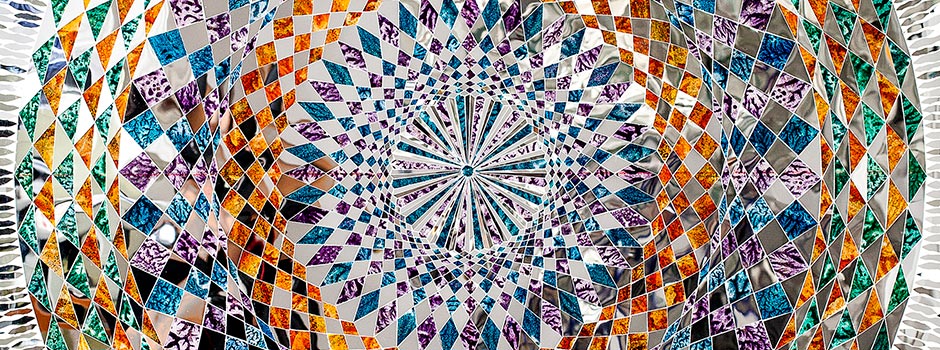
THE THIRD LINE AT ALSERKAL AVENUE: INAUGURAL EXHIBITION (Jan 5 – 30, 2016) Infinite Geometry by Monir Shahroudy Farmanfarmaian
Dec 29, 2015 Exhibition

The exhibition will reflect upon the different facets and materials of her geometric practice and will feature a range of drawings, carpets, and mirror works, showing the depth of her conceptual consideration throughout her career and medium. While many of the drawings and mirror works are new and only produced in the last few years, the presentation also includes drawings and carpets that were made in the early 90s, all of which have never been shown before.
_2015.jpg) Monir Shahroudy Farmanfarmaian, Hexagon (Second Family), 2015, Felt tip marker and pen on paper, 70 x 100 cm / Courtesy of The Third Line and the Artist
Monir Shahroudy Farmanfarmaian, Hexagon (Second Family), 2015, Felt tip marker and pen on paper, 70 x 100 cm / Courtesy of The Third Line and the Artist
The artist’s distinguished career spans more than five decades. In recent years, focus has expanded to examining Monir’s practice as a whole and looking at how the visual and conceptual language has developed over the decades, with most recently the Solomon R. Guggenheim Museum in New York presenting the artist’s first comprehensive exhibition in the United States in March of 2015.
Monir’s most well known work incorporates traditional reverse glass painting, mirror mosaics and principles of Islamic Geometry with a contemporary sensibility. Through wall-based panels, she presents both a detailed craft and contemporary abstraction that employs an interaction of surface texture, light and reflection, and colour and form. This characteristic mirror mosaic in Monir's work is an Iranian decorative form known as aineh-kari, a technique that dates back to the sixteenth century. Monir carries the same principles into her works on paper and textile. All of the drawings presented will be making their début, including earlier works from the 1990s that were produced while Monir was in exile in New York, following the Islamic Revolution in Iran.
 Monir Shahroudy Farmanfarmaian, Sunrise, 2015, Mirror and reversed glass painting on plaster and wood, 130 x 100 cm / Courtesy of The Third Line and the Artist
Monir Shahroudy Farmanfarmaian, Sunrise, 2015, Mirror and reversed glass painting on plaster and wood, 130 x 100 cm / Courtesy of The Third Line and the Artist
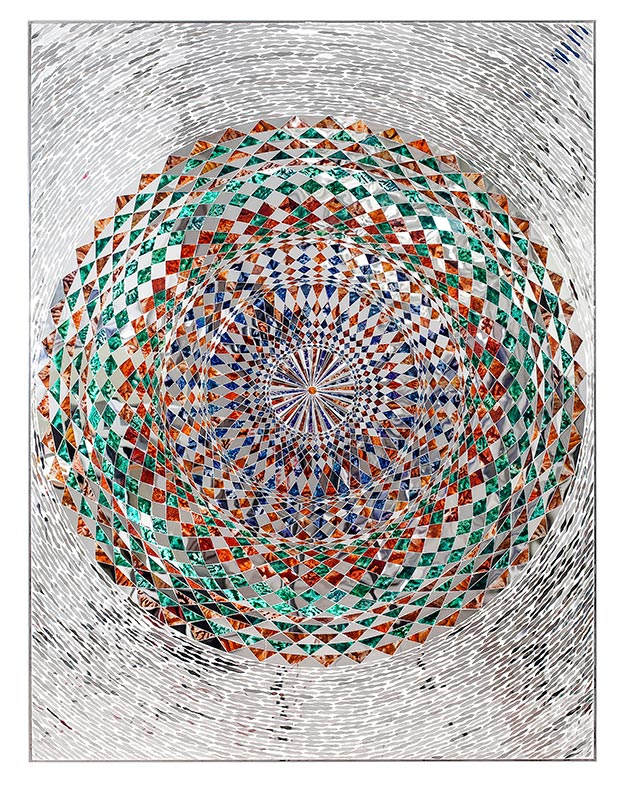 Monir Shahroudy Farmanfarmaian, Sunset, 2015, Mirror and reversed glass painting on plaster and wood, 130 x 100 cm / Courtesy of The Third Line and the Artist
Monir Shahroudy Farmanfarmaian, Sunset, 2015, Mirror and reversed glass painting on plaster and wood, 130 x 100 cm / Courtesy of The Third Line and the Artist
_2015.jpg) Monir Shahroudy Farmanfarmaian, Untitled (Maze 2), 2015_Mirror and reversed glass painting on plaster and wood, 160 cm diameter / Courtesy of The Third Line and the Artist
Monir Shahroudy Farmanfarmaian, Untitled (Maze 2), 2015_Mirror and reversed glass painting on plaster and wood, 160 cm diameter / Courtesy of The Third Line and the Artist
_2015.jpg) Monir Shahroudy Farmanfarmaian, Untitled (Maze), 2015_Mirror and reversed glass painting on plaster and wood, 135 x 135 cm / Courtesy of The Third Line and the Artist
Monir Shahroudy Farmanfarmaian, Untitled (Maze), 2015_Mirror and reversed glass painting on plaster and wood, 135 x 135 cm / Courtesy of The Third Line and the Artist
Examples of the earlier works from the 90s are more freehand and whimsical in nature, many of which became prototypes for carpets that were made by hand in Tabriz and Bijar, Iran. Those wool and naturally dyed silk carpets present a unique insight into Monir’s experiments in material that have not been showcased before. In contrast, the more recent felt tip marker and pen drawings on paper are in tightly calculated geometrical compositions, with a multitude of roulette curves – a direction that has also evolved in her mirror works.
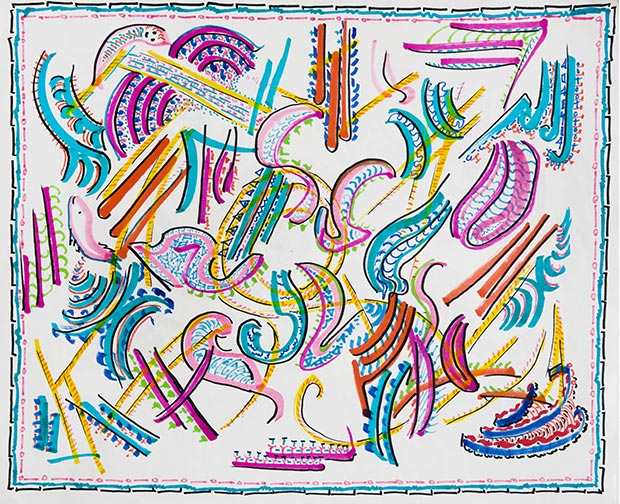 Monir Shahroudy Farmanfarmaian, Untitled, 1993, Felt tip marker on paper, 35 x 41.5 cm / Courtesy of The Third Line and the Artist
Monir Shahroudy Farmanfarmaian, Untitled, 1993, Felt tip marker on paper, 35 x 41.5 cm / Courtesy of The Third Line and the Artist
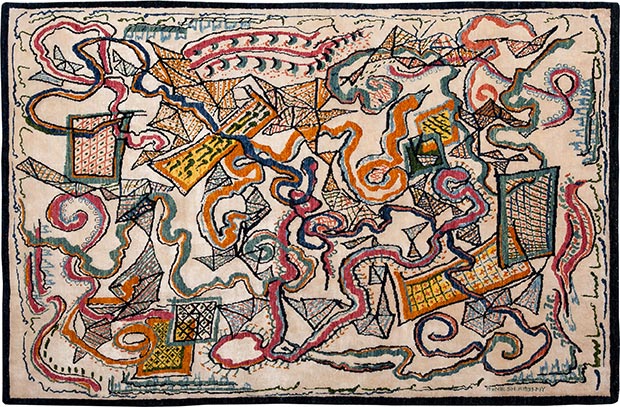 Monir Shahroudy Farmanfarmaian, Untitled, 1993, Felt tip marker on paper, 35 x 41.5 cm / Courtesy of The Third Line and the Artist
Monir Shahroudy Farmanfarmaian, Untitled, 1993, Felt tip marker on paper, 35 x 41.5 cm / Courtesy of The Third Line and the Artist
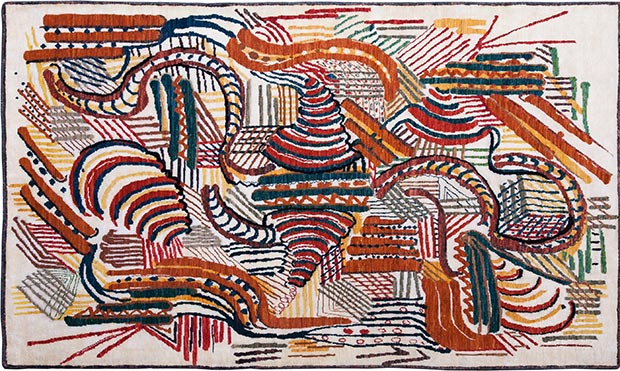 Monir Shahroudy Farmanfarmaian, Untitled, 1993, Naturally dyed silk and wool hand-woven in Tabriz (40 rows 580 x 870 knots), 100 x 151 cm / Courtesy of The Third Line and the Artist
Monir Shahroudy Farmanfarmaian, Untitled, 1993, Naturally dyed silk and wool hand-woven in Tabriz (40 rows 580 x 870 knots), 100 x 151 cm / Courtesy of The Third Line and the Artist
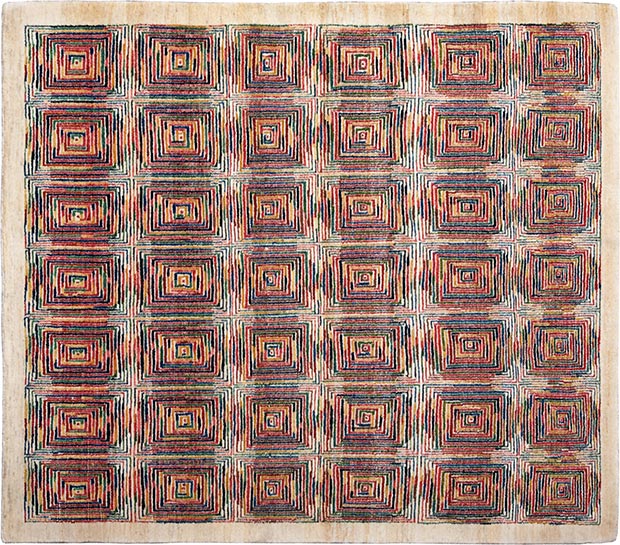 Monir Shahroudy Farmanfarmaian, Untitled, 1993, Naturally dyed silk and wool hand-woven in Tabriz (40 rows 619 x 910 knots), 103 x 177 cm / Courtesy of The Third Line and the Artist
Monir Shahroudy Farmanfarmaian, Untitled, 1993, Naturally dyed silk and wool hand-woven in Tabriz (40 rows 619 x 910 knots), 103 x 177 cm / Courtesy of The Third Line and the Artist
Monir Shahroudy Farmanfarmaian, Untitled, 2010, Wool hand-woven in Bijar (40 rows 600 x 780 knots), 122 x 140 cm / Courtesy of The Third Line and the Artist
 Monir Shahroudy Farmanfarmaian, Untitled, 2014, Felt tip marker and pen on paper, 70 x 100 cm / Courtesy of The Third Line and the Artist
Monir Shahroudy Farmanfarmaian, Untitled, 2014, Felt tip marker and pen on paper, 70 x 100 cm / Courtesy of The Third Line and the Artist
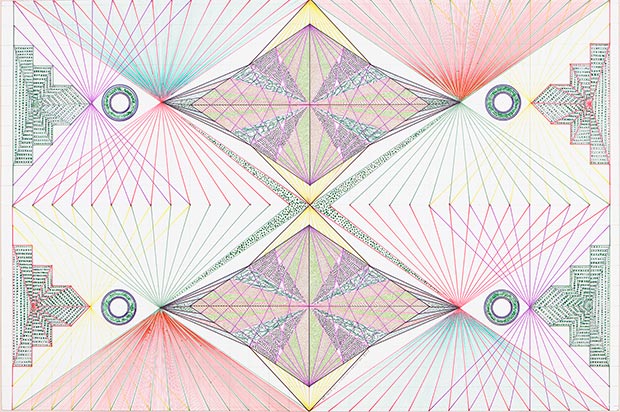 Monir Shahroudy Farmanfarmaian, Untitled, 2015, Felt-tip marker pen and glitter on paper, 70 x 100 cm / Courtesy of The Third Line and the Artist
Monir Shahroudy Farmanfarmaian, Untitled, 2015, Felt-tip marker pen and glitter on paper, 70 x 100 cm / Courtesy of The Third Line and the Artist
.jpg) Monir Shahroudy Farmanfarmaian, Untitled, 2015, Felt-tip marker pen and glitter on paper, 70 x 100 cm / Courtesy of The Third Line and the Artist
Monir Shahroudy Farmanfarmaian, Untitled, 2015, Felt-tip marker pen and glitter on paper, 70 x 100 cm / Courtesy of The Third Line and the Artist
.jpg) Monir Shahroudy Farmanfarmaian, Untitled, 2015, Felt-tip marker pen and glitter on paper, 70 x 100 cm / Courtesy of The Third Line and the Artist
Monir Shahroudy Farmanfarmaian, Untitled, 2015, Felt-tip marker pen and glitter on paper, 70 x 100 cm / Courtesy of The Third Line and the Artist
.jpg) Monir Shahroudy Farmanfarmaian, Untitled, 2015, Felt-tip marker pen and glitter on paper, 70 x 100 cm / Courtesy of The Third Line and the Artist
Monir Shahroudy Farmanfarmaian, Untitled, 2015, Felt-tip marker pen and glitter on paper, 70 x 100 cm / Courtesy of The Third Line and the Artist
.jpg) Monir Shahroudy Farmanfarmaian, Untitled, 2015, Felt-tip marker pen and glitter on paper, 70 x 100 cm / Courtesy of The Third Line and the Artist
Monir Shahroudy Farmanfarmaian, Untitled, 2015, Felt-tip marker pen and glitter on paper, 70 x 100 cm / Courtesy of The Third Line and the Artist
Monir was born in Qazvin, Iran, in 1924. Her works have been exhibited extensively in Iran, the U.S.A, Europe, and the Middle East, including the Soloman R Guggenheim Museum, NY; Fundação de Serralves, Porto; Prospect 3, New Orleans; Museum of Modern Art, NY; Leighton House Museum, London; Haus der Kunst, Munich; 29th Bienal de Sao Paulo; The Third Line, Dubai; and the Venice Biennale (1958, 1964, 1966 and 2009). Monir’s major commissioned installations include work for the Queensland Art Museum, Australia (2009), the Victoria & Albert Museum’s Jameel Collection (2006), the Dag Hammerskjöd building, NY (1981) and the Niyavaran Cultural Center (1977-78), as well as acquisitions by the Metropolitan Museum, NY; The Tehran Museum of Contemporary Art, the Museum of Contemporary Art Tokyo, and most recently the Guggenheim Museum, NY. Monir currently lives and works in Tehran, Iran.
The Third Line is a Dubai-based art gallery that represents contemporary Middle Eastern artists locally, regionally and internationally. The Third Line also hosts non-profit, alternative programs to increase interest and dialogue in the region. Represented artists include: Abbas Akhavan, Ala Ebtekar, Amir H. Fallah, Arwa Abouon, Babak Golkar, Ebtisam Abdulaziz, Farhad Moshiri, Fouad Elkoury, Golnaz Fathi, Hassan Hajjaj, Hayv Kahraman, Huda Lutfi, Joana Hadjithomas & Khalil Joreige, Laleh Khorramian, Lamya Gargash, Monir Shahroudy Farmanfarmaian, Pouran Jinchi, Rana Begum, Sahand Hesamiyan, Sara Naim, Sherin Guirguis, Shirin Aliabadi, Slavs and Tatars, Sophia Al-Maria, Tarek Al-Ghoussein, Youssef Nabil and Zineb Sedira.
Comments
Add a comment